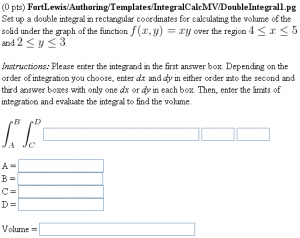Difference between revisions of "DoubleIntegral1"
Paultpearson (talk | contribs) m |
Paultpearson (talk | contribs) |
||
| Line 5: | Line 5: | ||
This PG code shows how to allow students to set up a double integral and integrate in either order. |
This PG code shows how to allow students to set up a double integral and integrate in either order. |
||
</p> |
</p> |
||
| − | * Download file: [[File:DoubleIntegral1.txt]] (change the file extension from txt to pg when you save it) |
||
| + | * File location in OPL: [https://github.com/openwebwork/webwork-open-problem-library/blob/master/OpenProblemLibrary/FortLewis/Authoring/Templates/IntegralCalcMV/DoubleIntegral1.pg FortLewis/Authoring/Templates/IntegralCalcMV/DoubleIntegral1.pg] |
||
| − | * File location in NPL: <code>FortLewis/Authoring/Templates/IntegralCalcMV/DoubleIntegral1.pg</code> |
||
<br clear="all" /> |
<br clear="all" /> |
||
| Line 286: | Line 285: | ||
Context()->texStrings; |
Context()->texStrings; |
||
BEGIN_SOLUTION |
BEGIN_SOLUTION |
||
| − | ${PAR}SOLUTION:${PAR} |
||
Solution explanation goes here. |
Solution explanation goes here. |
||
END_SOLUTION |
END_SOLUTION |
||
Revision as of 17:25, 16 June 2013
Setting up a Double Integral
This PG code shows how to allow students to set up a double integral and integrate in either order.
- File location in OPL: FortLewis/Authoring/Templates/IntegralCalcMV/DoubleIntegral1.pg
| PG problem file | Explanation |
|---|---|
|
Problem tagging: |
|
DOCUMENT(); loadMacros( "PGstandard.pl", "MathObjects.pl", "parserMultiAnswer.pl", ); TEXT(beginproblem()); |
Initialization:
Since there are multiple answer blanks that are dependent upon each other, we use |
Context("Numeric");
Context()->variables->are(
x=>"Real",dx=>"Real",
y=>"Real",dy=>"Real");
Context()->flags->set(reduceConstants=>0);
#
# limits of integration
#
$a = random(1,5,1);
$b = $a + random(1,4,1);
do { $c = random(1,5,1); } until ($c != $a);
do { $d = $c + random(1,4,1); } until ($d != $b);
#
# integrand and volume
#
$f = Formula("x*y");
$V = Formula("($b^2-$a^2) * ($d^2-$c^2) / 4");
#
# differentials and limits of integration
#
# Case 0, element 0 of each array below, is
# if the order of integration is dx dy
#
# Case 1, element 1 of each array below, is
# if the order of integration is dy dx
#
# "id" and "od" stand for inner and outer differential
#
@id = (Formula("dx"),Formula("dy")); # (case 0, case 1)
@od = (Formula("dy"),Formula("dx")); # (case 0, case 1)
#
# A = outer integral, lower limit
# B = outer integral, upper limit
# C = inner integral, lower limit
# D = inner integral, upper limit
#
@A = (Formula("$c"),Formula("$a")); # (case 0, case 1)
@B = (Formula("$d"),Formula("$b")); # (case 0, case 1)
@C = (Formula("$a"),Formula("$c")); # (case 0, case 1)
@D = (Formula("$b"),Formula("$d")); # (case 0, case 1)
$multians = MultiAnswer( $f, $id[0], $od[0], $A[0], $B[0], $C[0], $D[0] )->with(
singleResult => 1,
checker => sub {
my ( $correct, $student, $self ) = @_;
my ( $fstu, $idstu, $odstu, $Astu, $Bstu, $Cstu, $Dstu ) = @{$student};
if (
(
$f == $fstu &&
$id[0] == $idstu &&
$od[0] == $odstu &&
$A[0] == $Astu &&
$B[0] == $Bstu &&
$C[0] == $Cstu &&
$D[0] == $Dstu
)
||
(
$f == $fstu &&
$id[1] == $idstu &&
$od[1] == $odstu &&
$A[1] == $Astu &&
$B[1] == $Bstu &&
$C[1] == $Cstu &&
$D[1] == $Dstu
)
) {
return 1;
} elsif (
(
$f == $fstu &&
$id[0] == $idstu &&
$od[0] == $odstu &&
($A[0] != $Astu || $B[0] != $Bstu) &&
$C[0] == $Cstu &&
$D[0] == $Dstu
)
||
(
$f == $fstu &&
$id[1] == $idstu &&
$od[1] == $odstu &&
($A[1] != $Astu || $B[1] != $Bstu) &&
$C[1] == $Cstu &&
$D[1] == $Dstu
)
||
(
$f == $fstu &&
$id[0] == $idstu &&
$od[0] == $odstu &&
$A[0] == $Astu &&
$B[0] == $Bstu &&
($C[0] != $Cstu || $D[0] != $Dstu)
)
||
(
$f == $fstu &&
$id[1] == $idstu &&
$od[1] == $odstu &&
$A[1] == $Astu &&
$B[1] == $Bstu &&
($C[1] != $Cstu || $D[1] != $Dstu)
)
) {
$self->setMessage(1,"Check your limits of integration.");
return 0.94;
} elsif (
(
$f == $fstu &&
$id[0] == $idstu &&
$od[0] == $odstu &&
($A[0] != $Astu || $B[0] != $Bstu) &&
($C[0] != $Cstu || $D[0] != $Dstu)
)
||
(
$f == $fstu &&
$id[1] == $idstu &&
$od[1] == $odstu &&
($A[1] != $Astu || $B[1] != $Bstu) &&
($C[1] != $Cstu || $D[1] != $Dstu)
)
) {
$self->setMessage(1,
"Check your limits of integration and order of integration.");
return 0.47;
} else {
return 0;
}
}
);
|
Setup:
There are two separate cases: integrating with respect to
The |
Context()->texStrings;
BEGIN_TEXT
Set up a double integral in rectangular coordinates
for calculating the volume of the solid under the
graph of the function \( f(x,y) = $f \) over the
region \( $a \leq x \leq $b \) and \( $c \leq y \leq $d \).
$BR
$BR
${BITALIC}Instructions:${EITALIC}
Please enter the integrand in the first answer box.
Depending on the order of integration you choose,
enter ${BITALIC}dx${EITALIC} and ${BITALIC}dy${EITALIC}
in either order into the second and third answer boxes
with only one ${BITALIC}dx${EITALIC} or
${BITALIC}dy${EITALIC} in each box. Then, enter the limits of
integration and evaluate the integral to find the volume.
$BR
$BR
\( \displaystyle \int_A^B \int_C^D \)
\{ $multians->ans_rule(40) \}
\{ $multians->ans_rule(5) \}
\{ $multians->ans_rule(5) \}
$BR
$BR
A = \{ $multians->ans_rule(20) \} $BR
B = \{ $multians->ans_rule(20) \} $BR
C = \{ $multians->ans_rule(20) \} $BR
D = \{ $multians->ans_rule(20) \}
$BR
$BR
Volume = \{ ans_rule(40) \}
END_TEXT
Context()->normalStrings;
|
Main Text:
The only interesting thing to note here is that you must use |
$showPartialCorrectAnswers = 1; ANS( $multians->cmp() ); ANS( $V->cmp() ); |
Answer Evaluation: |
Context()->texStrings;
BEGIN_SOLUTION
Solution explanation goes here.
END_SOLUTION
Context()->normalStrings;
COMMENT('MathObject version. Allows integration in either order.');
ENDDOCUMENT();
|
Solution: |
